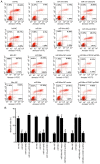MicroRNA‑195 suppresses cell proliferation, migration and invasion in epithelial ovarian carcinoma via inhibition of the CDC42/CCND1 pathway
- PMID: 32901852
- PMCID: PMC7521559
- DOI: 10.3892/ijmm.2020.4716
MicroRNA‑195 suppresses cell proliferation, migration and invasion in epithelial ovarian carcinoma via inhibition of the CDC42/CCND1 pathway
Abstract
Epithelial ovarian carcinoma (EOC) is the most common cause of gynecological cancer mortality, and poses a threat to women. MicroRNA‑195 (miR‑195) has been reported to induce apoptosis of human OVCAR‑3 cells by inhibiting the VEGFR2/AKT pathway. However, the role of miR‑195 in EOC remains unknown. A previous study reported that cell division cycle 42 (CDC42) can serve as a target gene of miR‑195 and mediate malignant progression of esophageal squamous cell carcinoma (ESCC). The aim of the present study was to investigate the role of miR‑195 in EOC and the regulation in CDC42/CCND1 pathway. Tissues samples and clinical materials were collected from 78 enrolled patients with EOC to analyze the expression and clinical significance of miR‑195, CDC42 and cyclin D1 (CCND1). Human EOC cell lines OVCA420, OVCAR‑3, A2780 and SKOV3 cell lines were used to assess the expression and function of miR‑195, CDC42 and CCND1 in vitro. Cell proliferation, the cell cycle and apoptosis, as well as the cell migratory and invasive abilities were detected in vitro using BrdU incorporation, colony formation, wound healing and Transwell invasion assays, along with flow cytometry. miR‑195 was downregulated, while CDC42 and CCND1 were upregulated in human EOC tissues and cells, and the aberrant expression of both was associated with increased EOC malignancy. Moreover, miR‑195 expression was negatively correlated with CDC42 and CCND1 expression levels, and negatively regulated these expression levels. Thus, it was suggested that miR‑195 functions as a tumor suppressor, but CDC42 and CCND1 act as tumor promoters based their abilities to enhance cell proliferation, cell cycle entry, migration and invasion, as well as decrease apoptosis in OVCAR‑3 cells. the present results demonstrated that miR‑195 inhibited human EOC progression by downregulating CDC42 and CCND1 expression. Furthermore, it was identified that miR‑195, CDC42 and CCND1 may be effective biomarkers for EOC diagnosis and treatment.
Figures






Similar articles
-
miR-211 suppresses epithelial ovarian cancer proliferation and cell-cycle progression by targeting Cyclin D1 and CDK6.Mol Cancer. 2015 Mar 11;14:57. doi: 10.1186/s12943-015-0322-4. Mol Cancer. 2015. PMID: 25889927 Free PMC article.
-
Circ-PGAM1 promotes malignant progression of epithelial ovarian cancer through regulation of the miR-542-3p/CDC5L/PEAK1 pathway.Cancer Med. 2020 May;9(10):3500-3521. doi: 10.1002/cam4.2929. Epub 2020 Mar 13. Cancer Med. 2020. PMID: 32167655 Free PMC article.
-
miR-20b-5p functions as tumor suppressor microRNA by targeting cyclinD1 in colon cancer.Cell Cycle. 2020 Nov;19(21):2939-2954. doi: 10.1080/15384101.2020.1829824. Epub 2020 Oct 12. Cell Cycle. 2020. PMID: 33044899 Free PMC article.
-
Identification and validation of a novel long non-coding RNA (LINC01465) in ovarian cancer.Hum Cell. 2023 Mar;36(2):762-774. doi: 10.1007/s13577-022-00842-x. Epub 2022 Dec 13. Hum Cell. 2023. PMID: 36513868 Review.
-
Aberrant MAPK Signaling Offers Therapeutic Potential for Treatment of Ovarian Carcinoma.Onco Targets Ther. 2022 Nov 5;15:1331-1346. doi: 10.2147/OTT.S361512. eCollection 2022. Onco Targets Ther. 2022. PMID: 36388156 Free PMC article. Review.
Cited by
-
circDENND4C, a novel serum marker for epithelial ovarian cancer, acts as a tumor suppressor by downregulating miR-200b/c.Ann Med. 2023 Dec;55(1):908-919. doi: 10.1080/07853890.2023.2185289. Ann Med. 2023. PMID: 36896567 Free PMC article.
-
Identification of potentially actionable genetic variants in epithelial ovarian cancer: a retrospective cohort study.NPJ Precis Oncol. 2024 Mar 22;8(1):71. doi: 10.1038/s41698-024-00565-2. NPJ Precis Oncol. 2024. PMID: 38519644 Free PMC article.
-
In silico analysis to identify novel ceRNA regulatory axes associated with gallbladder cancer.Front Genet. 2023 Feb 16;14:1107614. doi: 10.3389/fgene.2023.1107614. eCollection 2023. Front Genet. 2023. PMID: 36873948 Free PMC article.
-
Identification of key genes and pathways related to cancer-associated fibroblasts in chemoresistance of ovarian cancer cells based on GEO and TCGA databases.J Ovarian Res. 2022 Jun 23;15(1):75. doi: 10.1186/s13048-022-01003-2. J Ovarian Res. 2022. PMID: 35739532 Free PMC article.
-
Unlocking the potential of non-coding RNAs in cancer research and therapy.Transl Oncol. 2023 Sep;35:101730. doi: 10.1016/j.tranon.2023.101730. Epub 2023 Jul 3. Transl Oncol. 2023. PMID: 37406550 Free PMC article.
References
-
- Parizadeh SM, Jafarzadeh-Esfehani R, Ghandehari M, Hasanzadeh M, Parizadeh SMR, Hassanian SM, Rezaei-Kalat A, Aghabozorgi AS, Rahimi-Kakhki R, Zargaran B, et al. Circulating and tissue microRNAs as biomarkers for ovarian cancer prognosis. Curr Drug Targets. 2019;20:1447–1460. doi: 10.2174/1389450120666190708100308. - DOI - PubMed
-
- Menke K, Schwermer M, Falke K, Felenda J, Beckmann C, Stintzing F, Voigt A, Schramm A, Zuzak TJ. Taraxacum officinale extract induces antitumorigenic effects in ovarian carcinoma cell lines. Eur J Gynaecol Oncol. 2019;40:106–112.
MeSH terms
Substances
LinkOut - more resources
Full Text Sources
Research Materials
Miscellaneous

